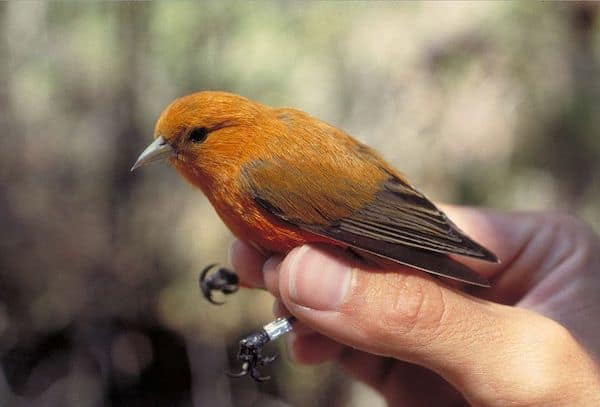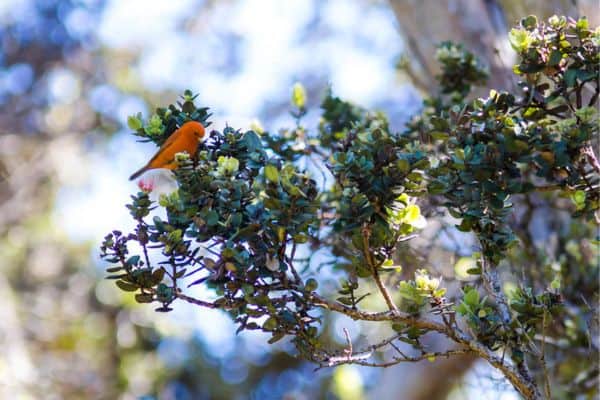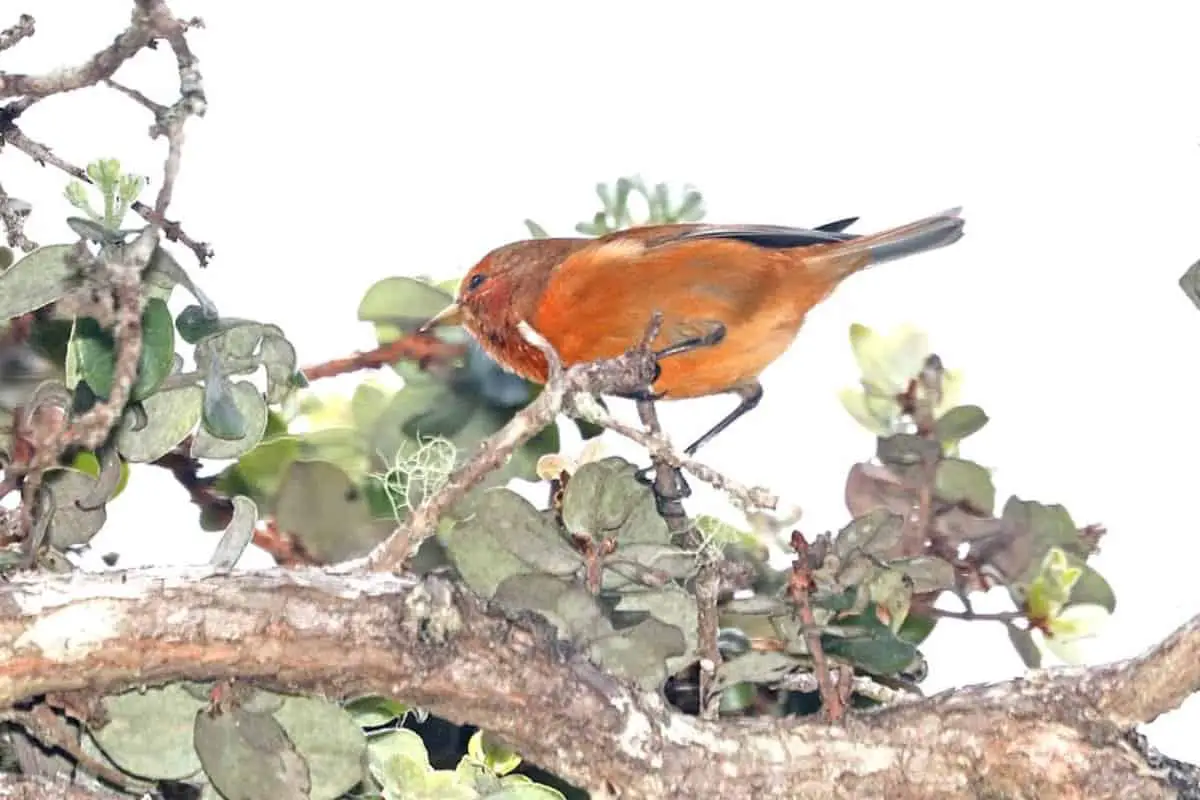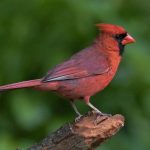Common Name: Hawaiʻi ʻAkepa
Scientific Name: (Loxops coccineus)| Size | Diet | Range in Hawaii | Status in Hawaii |
|---|---|---|---|
| 4.5 in. | insects and other small invertebrates | Big Island | Endangered |
The Hawaiʻi ʻakepa (Loxops coccineus) is a fascinating and unique bird species that is native to the Hawaiian Islands. With its distinctive red and yellow plumage and playful behavior, this honeycreeper is a beloved sight in its natural habitat.
However, the species is currently listed as endangered due to habitat loss and other threats. In this article, we’ll explore the fascinating world of the Hawaiʻi ʻakepa, its role in Hawaii’s ecosystem, and the efforts being made to protect and preserve this incredible bird.
Hawaiʻi ʻAkepa
Appearance

The Hawaiʻi ʻAkepa is a small bird with a distinctive appearance. It has a vibrant crimson plumage that covers its body, with a darker shade on its wings and tail.
The male and female Hawaiʻi ʻAkepas exhibit similar coloration. This species has a compact and rounded body shape, measuring approximately 4.5 inches (11 centimeters) in length. Its small size and bright red color make the Hawaiʻi ʻAkepa a striking and visually appealing bird.
Diet
The diet of the Hawaiʻi ʻAkepa primarily consists of insects and other small invertebrates. It forages for its food by actively searching through the vegetation, probing and gleaning insects from leaves, bark, and crevices.
The Hawaiʻi ʻAkepa has a specialized bill that is slightly decurved, allowing it to reach into narrow spaces to extract hidden prey. Its diet may include various insects, spiders, caterpillars, and other arthropods.
Nesting
The nesting behavior of the Hawaiʻi ʻAkepa is relatively less known compared to other aspects of its biology. Like other honeycreepers, it is believed to construct cup-shaped nests made of twigs, leaves, and other plant materials. These nests are typically built in the forks of branches or in the dense foliage of trees, providing protection and camouflage for the nesting birds.
The breeding season of the Hawaiʻi ʻAkepa is thought to occur during the spring and summer months when food resources are more abundant. Female ʻAkepas are responsible for incubating the eggs, while both parents likely contribute to feeding and caring for the nestlings. The exact number of eggs laid by the Hawaiʻi ʻAkepa and the duration of the incubation period are not well documented.
Behavior

The Hawaiʻi ʻAkepa (Loxops coccineus) is known for its active and agile behavior. It spends most of its time foraging in the upper canopy of native forests, searching for insects and small arthropods.
This bird has been observed climbing and clinging to tree branches and trunks, using its sharp bill to probe crevices and extract prey. It often moves in small foraging flocks, consisting of family groups or mixed-species feeding associations.
During the breeding season, the male Hawaiʻi ʻAkepa displays territorial behavior, defending its nesting site from intruders. The male will perform courtship displays to attract a mate, including fluffing its feathers, spreading its wings, and vocalizing.
The female builds a small cup-shaped nest using materials such as moss, bark, and leaves. The nesting sites are usually located in tree cavities, which provide protection and shelter for the eggs and nestlings.
Hawaiʻi ʻAkepas are generally shy and elusive birds, making them challenging to observe in the wild. They are known for their rapid and precise flight, darting among the trees with agility. Despite their small size, they have a distinctive and melodious song, which they use for communication and territorial defense.
Habitat
The Hawaiʻi ʻAkepa is primarily found in montane wet and mesic forests. It inhabits a range of forest types, including native ʻōhiʻa forests dominated by ʻōhiʻa lehua trees (Metrosideros polymorpha) and mixed montane forests with koa (Acacia koa) and other native tree species.
These birds are typically found at elevations between 1,200 and 6,500 feet (366 to 1,981 meters) above sea level. They prefer areas with dense vegetation, including mosses, ferns, and epiphytic plants that provide abundant food resources and suitable nesting sites. The presence of native trees and understory plants is crucial for their survival, as they rely on them for food, shelter, and nesting.
Range

The Hawaiʻi ʻAkepa is endemic to the Hawaiian Islands. It is primarily found on the Big Island of Hawaiʻi, where it inhabits the forests of various elevations. Early observations indicated that the Hawaiʻi ʻAkepa was present in most forests across the island, with sightings as low as 550 meters above sea level.
However, in recent times, the species has been restricted to elevations above 1100 meters in disjunct areas. The precise range and distribution of the Hawaiʻi ʻAkepa within these specific areas may vary. It is important to note that the population of the Hawaiʻi ʻAkepa has declined significantly, and conservation efforts are underway to protect and preserve this species
Conservation Status
The Hawaiʻi ʻAkepa is currently listed as an endangered species. Its population has experienced significant declines, primarily due to habitat loss, habitat degradation, and the introduction of invasive species. The destruction and fragmentation of its native forest habitat have severely impacted the species, limiting its distribution and threatening its survival.
Conservation efforts are underway to protect and restore the remaining habitat of the Hawaiʻi ʻAkepa. These efforts include the removal of invasive plant species, reforestation initiatives, and the establishment of protected areas. Conservation organizations and government agencies are also working to mitigate other threats, such as predation by non-native species and the potential impacts of climate change.
Additionally, captive breeding and reintroduction programs have been implemented to boost the population of the Hawaiʻi ʻAkepa and ensure its long-term survival. Public awareness campaigns, research studies, and monitoring programs are crucial components of conservation initiatives to better understand the species’ ecology and support its conservation.
Interesting Facts
1. Striking plumage
The male Hawaiʻi ʻAkepa showcases a vibrant red-orange plumage, while the female has a more subdued olive-brown coloration.
2. Specialized beak
It possesses a unique crossed bill adaptation, which is perfectly suited for extracting nectar and probing into flowers for insects.
3. Unique song
The male Hawaiʻi ʻAkepa has a distinctive, melodious song that can be heard during the breeding season, serving as a means of communication and territorial defense.
4. Specialized feeding behavior
The Hawaiʻi ʻAkepa plays a crucial role in pollination as it feeds on nectar from native Hawaiian flowers, aiding in the transfer of pollen and contributing to the plant’s reproductive cycle.
Frequently Asked Questions
1. Where can the Hawaiʻi ʻAkepa be found?
The Hawaiʻi ʻAkepa is found in certain native forests on the Big Island of Hawaiʻi.
2. Can the Hawaiʻi ʻAkepa be kept as a pet?
No, it is illegal to keep the Hawaiʻi ʻAkepa as a pet. They are wild birds and should be allowed to live in their natural habitats.
3. Is the Hawaiʻi ʻAkepa endangered?
Yes, the Hawaiʻi ʻAkepa is listed as an endangered species due to habitat loss, predation, and disease.




